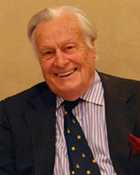Geoffrey Wellum
| Geoffrey Wellum | |
|---|---|
 Geoffrey Wellum in 2009 | |
| Birth name | Geoffrey Harry Augustus Wellum |
| Born |
4 August 1921 Walthamstow, England |
| Allegiance | United Kingdom |
| Service/branch | Royal Air Force |
| Years of service | 1939–1961 |
| Rank | Squadron Leader |
| Service number | 42925 |
| Battles/wars | Battle of Britain |
| Awards | Distinguished Flying Cross |
Squadron Leader Geoffrey Wellum DFC (born 4 August 1921[1]), is a British Battle of Britain fighter pilot and author. Born an only child in Walthamstow, England, Wellum was educated at Forest School, Snaresbrook before serving in the RAF.
Career
1921–1942
Aged eighteen, he signed up on a short-service commission with the Royal Air Force in August 1939. The first aircraft he flew was the Tiger Moth at Desford airfield in Leicestershire, after successfully completing the course he then went on to fly the North American Harvard at RAF Little Rissington with 6FTS.
He was then posted directly in May 1940 to 92 Squadron, flying Spitfires. He saw extensive action during the Battle of Britain. His first Commanding Officer was Roger Bushell, (later immortalised in The Great Escape),[2] and his close colleagues included Brian Kingcome[3]

He claimed a Heinkel He 111 shot down on 11 September, and a quarter share in a Junkers Ju 88 downed on 27 September 1940. Two (and one shared) Messerschmitt Bf 109s were claimed 'damaged' during November 1940. A Bf 109 was claimed shot down on 9 July 1941 over France.[4]
In February 1942 he was transferred to 65 Squadron based at Debden, being appointed a Flight Commander in March 1942.
On 11 August 1942, Wellum led eight Spitfires launched from the carrier HMS Furious to reinforce the fighter complement at Luqa airfield on Malta. Here he joined 145 Squadron on air defence duties before being rested after a severe bout of sinusitis.
1943–1961
Wellum suffered severe battle fatigue after three years' intensive flying, because of the immense strain that frontline British fighter pilots were put under during that period. He returned from Malta to Britain, becoming a test pilot on the Hawker Typhoon, based at Gloster Aircraft.
He finished the war as a gunnery instructor, staying in the RAF, first as a staff officer in West Germany, followed by a four year tour with 192 Squadron. He married Grace, his wartime girlfriend and they had three children.[2]
1961 and afterwards
Wellum left the Royal Air Force in 1961, working with a firm of commodity brokers in the City of London, set up his own business, and then retired to Mullion, Cornwall. He had written a memoir of his time as a Spitfire pilot but never intended it for publication. However in 2000 he gave it to a young author called James Holland, who showed it to friends at Penguin, and they immediately decided to publish it.[2]
Published works
Wellum wrote a widely acclaimed book about his experiences during World War II, entitled First Light: The Story of the Boy Who Became a Man in the War-Torn Skies Above Britain. New York: Viking Books, 2002 (hardcover, ISBN 0-670-91248-4); Hoboken, NJ: Wiley & Sons, 2003 (hardcover, ISBN 0-471-42627-X); London: Penguin Books, 2003 (paperback, ISBN 0-14-100814-8).
Television
Wellum has contributed to various TV documentaries on the Battle of Britain, including Spitfire Ace produced by RDF Media/Channel 4 (2004),[5] Dangerous Adventures for Boys produced by Channel 5 (2008).[6] and The Spitfire: Britain's Flying Past produced by the BBC (Sep 2011) [7]
To mark the 70th anniversary of the Battle of Britain, the BBC commissioned a one-off drama for TV called First Light, based on Wellum's book of the same name. The film was first shown by the BBC on 14 September 2010.[8]
Honours and awards
- 5 August 1941 - Flying Officer Geoffrey Harry Augustus Wellum (42925) of No. 92 Squadron RAF is awarded the Distinguished Flying Cross (DFC) in recognition of gallantry displayed in flying operations against the enemy:
This officer has been with his squadron since the evacuation of Dunkirk. During the recent offensive operations over France he has led his section and flight with great skill and determination. He has destroyed at least three enemy aircraft and damaged several others.— London Gazette[9]
References
- ↑ RAF.mod.uk: 92 Squadron - Geoffrey Wellum
- ↑ 2.0 2.1 2.2 Geoffrey Wellum: Prize fighter The Independent 4-June-2002
- ↑ Interview with James Holland, and curiously, in his book, Kingcome is spelled all the time as "Kingcombe". Wellum describes Kingcome as "the finest fighter pilot I ever flew with" and recommends his book A Willingness to Die
- ↑ 'Those Other Eagles' Shores, 2004, page 635
- ↑ http://www.channel4.com/community/showcards/S/Spitfire_Ace.html
- ↑ Martin Kemp: The Battle of Britain (1/6) | Dangerous Adventures For Boys | TV Highlights | Throng
- ↑ http://www.bbc.co.uk/programmes/b0153yb6 The Spitfire: Britain's Flying Past
- ↑ BBC - BBC Two Programmes - First Light
- ↑ The London Gazette: no. 35238. p. 4516. 5 August 1941. Retrieved 27 August 2010.
10. A Cobra in the Sky. Simon Morris.The History of 92 Squadron RAF
|